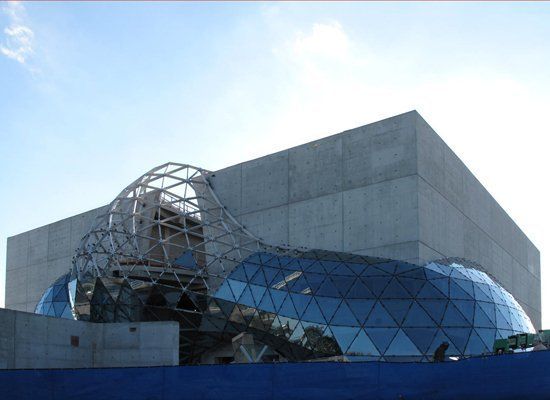With a grand opening on January 11, 2011, the new Salvador Dalí Museum by architecture and design firm HOK channels the spirit of the famous surrealist artist. Located eight blocks north of its current location at One Dali Boulevard in St. Petersburg, FL, the building is comprised of sister glass forms: Enigma and its smaller sister, Igloo are based on the work of Buckminster Fuller, the man who pioneered geodesic geometries and domes and was coincidentally a friend of Dali.
Below is a slide show of the space in progress, and an excerpt of a conversation I had with head designer Yann Weymouth about the new museum.
How did you arrive at Bucky Fuller as a point of inspiration?
Buckminster Fuller was and is an important influence in my work, as he is to many other designers. He sought ways to make things stronger, lighter and more efficient, and was inspired by nature, sailing and aviation technology. He was a pioneer in understanding the relationship between our advancing technology and its effect upon the planet, the balance of water and oxygen that makes life possible and its dependence upon a healthy ecology.
Fuller was also a friend and influence upon Salvador Dalí, and he designed the geodesic dome that crowns the Teatro-Museo Dalí in Figueres, which Dalí himself designed for his personal collection. Thus it seemed absolutely appropriate to use a geodesic structure to shape the new museum's skylight and window system. The way we used the geometry, however, is a bit different from how Fuller did, in that we were able to use modern computer-aided geometries, structural calculations and wind analysis in our design to make the more complex shapes we needed, and to use computer - "CnC" tooling to fabricate the unique angles and shapes required. These were technologies not yet available to Bucky, but which I am sure he would appreciate today.
With such a site specific design, what were some of the specific challenges you had to address during the design process?
Every site and climate is different, and our bay front site in Florida has its own challenges. The first is the dangers to the collection and archives of the museum form a severe hurricane, because it is situated at the water's edge. The museum requested a design that can withstand a 200-year event, such as a direct hit from a category 5 hurricane, with 165 mph sustained winds, and missile impact from wind-borne debris and a 28 foot storm surge. Thus our design is essentially a fortress of 18" thick steel-reinforced waterproof concrete walls, and the geodesic triangulated glass "Enigma" and "Igloo" are rated for a category 3 storm. Within the building, all mission-critical functions are above grade level, and further protected by roll-down hurricane shutters.
Of course, these functional measures greatly affected the form and appearance of the museum, and we have intentionally emphasized the difference between the strong, almost brutal concrete mass of the building with the transparent, reflective, flowing and organic shape of the glass geodesic "Enigma."
Alternatively, did you come across any pleasant surprises provided by the buildings environment?
The bay front site donated by the city of St. Petersburg, overlooking the yacht basin is perfectly beautiful, and we have tried to take every advantage from it, in views outward from the building, and from the East "Avant-Garden."
How did Dali's work and personality play a role in the conceptualization of the design?
Dali was fascinated by science, mathematics and perceptual psychology, as designers, so are we. We felt free to exploit the best of our current technology to accomplish our design for the museum. However, I did feel that it would be wrong or kitsch to make overt gestures toward Dali's own work, so HOK's design remains abstract in its references to Surrealism. The spiral stair is a direct reference to Dali's fascination with spirals, the Golden Section, and to the double helix of DNA. I hope that it does so with a measure of restraint. Our aim in the design of the museum is to showcase the works of a great 20th century master. I hope we have succeeded in our task.
